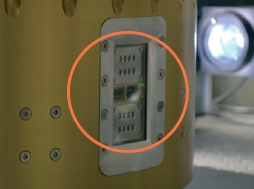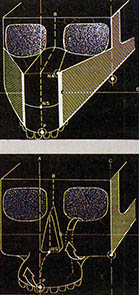글랜 랭스톤씨가 지휘하는 미국 국립전파천문대의 천문학팀은 지난 1990년 하늘에서 조그마한 고리모양의 전파를 관측하였다. 이와같은 발견은 두번째이며 우리가 하늘에서 찾아보기 힘든 매우 이례적인 현상이다. 이는 '중력렌즈'로 불린다.
이러한 현상이 존재할 수 있다는 최초의 암시는 아인슈타인박사가 일반상대성이론을 고안해 냈던 지난 1916년에 있었다. 상대성이론에 의하면 빛은 유리를 통과할때 비스듬히 꺾이는 것처럼 질량이 큰 물체의 근처를 지날 때에도 굴절되어야 한다.
두 굴절의 차이란, 빛은 유리에 의해 크게 굴절되지만 중력은 빛을 아주 미미하게밖에 굴절시키지 못한다는 것이다. 그럼에도 불구하고 지난 1919년의 개기일식 때, 달에 가리워진 태양의 주변에 있는 별들은(그래서 보통때 태양이 가리워지지 않았을 때는 보이지 않지만 그때만은 관측되는 별들)바로 그러한 굴절로 말미암아 약간 제 위치에서 벗어난 것처럼 보였다.
우주의 머나먼 곳의 어느 물체나 태양을 지나도록 사방으로 광선을 발사하고 이 빛은 다시 사방에서 굴절되어 한 지점으로 초점이 맞추어졌다고 가정해보자. 만약 이 초점이 지구 부근에 맞춰졌다면 우리는 빛을 발한 그 물체를 태양을 둘러싸는 빛의 원형으로 보게될 것이다.
그러나 이것은 불가능하다. 빛은 매우 조금밖에 굴절되지 않기 때문에 초점이 맞춰지려면 수광년의 거리가 필요한 까닭이다. 이는 빛의 초점을 이루는 무거운 물체가 우리로부터 많고 많은 광년으로 떨어져 있어야 한다는 것이며 그 빛을 발하는 물체는 더욱 많고 많은 광년의 거리에 위치함을 뜻한다.
어느 물체건 그렇게 멀리 있으면 관측하기조차 어렵다는 가정때문에 천문학자들은 중력렌즈가 흥미로운 이론적 개념이기는해도 실제로 관측이 가능한 것이라고 판단하지는 않았다.
그런데 1963년에 준성들이 발견됐다. 이 별들은 매우 밝고 매우 멀리있는 것들이다. 이들은 수십억 광년이상 멀리 있으며 그들 자신이 방출하는 강력한 빛과 전파에 의해 탐지된다. 전파는 빛의 파장이 갖는 모든 특성을 지니고 있으며 따라서 그 역시 굴절된다.
만약 그렇다면 멀리있는 준성과 우리사이에 그 무엇인가 무거운 물체가 있어 준성의 전파를 지구 근방에 초점이 맞도록 하고 있다고 가정해보자. 우리는 준성을 흔히 볼 수 있는 빛나는 천체가 아니라 초점을 맞추어주는 어떤 무거운 물체를 둘러싼 고리형태로 보게 될 것이다.
물론 그 무거운 물체는 우리와 준성사이의 어느 정확한 지점에 위치하고 있지 않아도 된다. 전파가 한 방향에 치우치고 다른 방향으로 미미할 수도 있는 것이다. 이런 경우 전파고리 대신 우리는 약간 모양이 일그러진 준성을 보게 될 뿐이며 어쩌면 하나 옆에 조그마한 다른 하나를 둔 듯한 이중 준성을 보게 될는지도 모른다.
지난 1979년 3월9일엔 서로 꼭 붙은 이중 준성이 발견됐다. 뿐만아니라 그들의 스펙트럼은 꼭 같아서 초점을 맞추는 효과에 의해 약간 일그러지긴 했지만 하나의 준성을 보고 있다고 자연스럽게 가정하도록 만들었다. 사실인즉, 정밀 관측결과에 따르면 그 준성앞엔 너무 멀어 보기조차 힘든 대형 은하 무리가 자리잡고 있음이 밝혀졌다.
그후 일그러진 모양의 은하는 일곱차례나 포착됐으나 1987년에 이르러서야 은하계뒤에서 고리 모양의 전파를 형성하는 준성이 처음으로 발견됐다. 거기엔 완벽한 중력렌즈, 혹은 가끔씩 일컬어지듯이 '아인슈타인 고리'가 존재한 것이었다. 그런데 이제 두번째 아인슈타인 고리가 나타났으며 천문학자들은 그처럼 빛을 내는 준성이 얼마나 멀리있는가를 말할 수 있게 됐다. 즉 28억 광년에 해당하는 거리이다.
이외에도 천문학자들은 초점을 맞추어주는 물체도 밝혀냈다. 그것은 태양질량의 3천억배 가량되는 거대한 은하로서 그 준성과 우리사이에 정확하게 위치하고 있다. 다시말해 우리가 소속한 은하수만큼 크거나 어쩌면 더 큰 은하라는 것이다.
이러한 사실은 소위 '사라진 질량'에 관한 궁금증을 낳는다. 이는 천문학자들을 괴롭히는 두가지 수수께끼중의 하나이기도 하다.(다른 하나는 은하들이 태초에 어떠한 과정을 거쳐 만들어졌나이다.)
우주의 모든 질량이 우리가 볼 수 있는 물체의 형태로 존재하지만은 않는다고 생각하는데는 이유가 있다. 우리가 모든 은하들속에 있는 천체들의 질량을 합산해보아도 그 결과는 중력효과를 불러일으키기에 충분한 질량이 되지 못하기 때문이다. 따라서 어떤 천문학자들은 그 사라진 질량이 우리가 눈으로 식별할 수 있는 물체의 질량의 2백배에 이를 것이라 가정하지만 아무도 보이지 않는 질량이 과연 무엇인지는 모른다.
다른 천문학자들은 그 사라진 질량은 사실은 존재하지 않는다고 굳게 주장하는데 이 주장은 목소리가 높고 격렬하기까지하다. 이번에 발견된 두번째 아인슈타인 고리와 관련하여 중재역할을 맡은 은하의 질량은 그 속의 보이는 별들 질량의 8~16배쯤 되는 듯 하다. 이는 실제적인 증명은 되지못하지만 사라진 질량을 주장하는 편을 거드는 획기적인 사건이 아닐 수 없다.
A team of astronomers from the National Radio Astronomy Observatory in 1990, under the lead of Glen Langston, located a tiny ring of radio waves in the sky. It was the second such object to be discovered and it is one of the most unusual phenomena we can expect to see in the sky. It is called a "gravitational lens."
The first hint that such a thing could exist came in 1916, when Albert Einstein devised his general theory of relativity. According to that theory, light rays ought to be bent if they passed near a very massive object, just as they are bent as they pass obliquely into glass.
The difference is that while light is bent enormously by glass(refraction), gravitational pull bends light only exceedingly slightly. Even so, in 1919, during a total eclipse, it was determined that the stars near the eclipsed sun(and therefore visible, as they would not ordinarily be if the sun were not eclipsed) seemed slightly out of position because of such bending.
Suppose some distant source of light sent rays past the sun on all sides, and the light was bent everywhere so that it came to a focus. If that focus was achieved near Earth, we would see the distant source of light as a circle of light all around the sun.
This, however, is impossible. Light is bent so slightly that it would come to a focus only over a distance of many light years. This means that the massive object that focuses the light must be many, many light-years from us, and the source of light must be many, many light-years further away still.
It was not supposed that object far enough away could be detected at all, so astronomers felt that while the gravitational lens was an interesting theoretical concept, it was not something that could possibly ever be observed.
But then in 1963, quasars were observed. These are very bright and very distant objects. They are billions of light years away and can be seen by the enormous light they radiate and even more so by their radio waves. The radio waves have all the properties of light waves and they, too, can be bent.
Suppose, then, that exactly between a distant quasar and ourselves is something massive that can bend the radio waves of the quasar and focus them in Earth's vicinity. We could see the quasar not as the usual little smudge of radiation but as a ring centering around the massive object that is doing the focusing.
Of course, the massive object may not be exactly between us and the quasar. The radio waves may skim by mostly on one side and very little on the other. Instead of a ring of radio waves, we would simply see a distorted quasar; perhaps a double quasar, one on one side, and a smaller one on the other.
On March 9, 1979, a double quasar was found, the two components of which were very close to each other. What's more, the spectra were so identical that it was natural to assume we were really seeing one quasar, which was being distorted by a focusing effect. Sure enough, on close inspection, it turned out that there was a giant cluster of galaxies in front of the quasar, a cluster so distant it could barely be seen.
Seven more cases of distorted galaxies were detected afterward but it was not until 1987 that a quasar was found with a galactic cluster exactly in front of it so that it formed a ring of radio waves. There was the perfect gravitational lens or, as it is sometimes called, an "Einstein ring." Now a second Einstein ring has been discovered, and the astronomers have been able to tell how far away the quasar must be that gives rise to the radiation. The estimate is that it is 2.8 billion light-years away.
What's more, they have also detected the object that is doing the focusing. It is a large galaxy that is exactly in between the quasar and ourselves and that has a mass equal to about 300 billion times that of our sun. In other words, it is galaxy that is as large as, or perhaps larger than, our own Milky Way Galaxy.
This raises a question about "missing mass." This is one of the two question that bother astronomers.(The other is the mechanism by which the galaxies formed in the first place.)
There are reasons to think that not all the mass in the universe is in the form of objects we can see. If we add up the mass of all the stars in all the galaxies, it seems to turn out that there just isn't enough mass to account for gravitational effects. Some astronomers think that the missing mass is as much as 200 times greater than the mass we can see, but no one knows what the nature of the unseen mass might be.
Other astronomers are adamant that the missing mass does not really exist- and their argument is loud and furious. In connection with the new Einstein ring, the mass of the intervening galaxy seems to be between 8 and 16 times the mass of the stars we can see in it. This is not actual proof, but it is a blow on the side of missing mass.
이 기사의 내용이 궁금하신가요?
기사 전문을 보시려면500(500원)이 필요합니다.
1991년 04월 과학동아 정보
🎓️ 진로 추천
- 천문학
- 물리학
- 지구과학

















